A Transect Method for Promoting Landscape Conservation in the Climate Change Context: A Case-Study in Greece
Abstract
:1. Introduction
Aims of the Study
2. Material and Methods
2.1. Methodological Background
2.2. Developing the “Landscape Transect Method” for Climate Change Study
- (1)
- The transect zone is sufficiently broad that: (i) understanding gained from research on the transect can be applied beyond a narrow spatial sector, and (ii) it crosses a transition between systems dominated by different major ecosystems (e.g., forest/prairie, mountains/lowlands) and climate zones.
- (2)
- The transect is located in a region that is likely to be altered by forcing from components of global environmental change, where the alteration is itself likely to be significant at least at the regional level.
- (3)
- The transect represents a coherent set of sites that differ relatively straightforwardly and continuously in a major environmental factor that is predicted to change significantly (or has already changed) as a consequence of environmental change (anthropogenic or otherwise).
- -
- Topography and landscape relief
- -
- Watershed boundaries
- -
- Dominant land use formations
- -
- Current vegetation patterns
- -
- Dominant ecosystems (e.g., natural patterns)
- -
- Perceptual characteristics (e.g., common character area).
- (a)
- Desk study:
- -
- Land cover and land uses (Corine CLC and Google Earth);
- -
- Natural drainage basin boundaries determined by watershed boundaries;
- -
- Protected or designated area boundaries;
- -
- People’s perceptions of the points of view within a landscape area (on-line georeferenced photos, Google Earth photos);
- -
- Other information gathering from discussions with experts and local citizens.
- (b)
- Field study:
- -
- Confirmation of the final borders of the selected landscape areas and the landscape points (analysis of drone video footage). The limits of each landscape area depend on the topography and the extent of homogeneous landscape formations in the area. A very important horizon “border” of the landscape is the watershed boundary; on hills and mountain ridges.
2.3. The Climate Change Assessment Methodology
- -
- P: represents the annual average precipitation (mm);
- -
- M: represents the average maximum monthly air temperature of the warmest month in absolute degrees (K);
- -
- m: represents the average minimum monthly air temperature of the coldest month in absolute degrees (K).
2.4. The Study Area
3. Results
3.1. Landscape in the RAAP
3.2. Applying the Descriptive and Landscape Assessment Protocols
3.3. Landscape Typology
3.4. Climate Change Impacts
3.5. Sensitivity to Desertification
- (a)
- The largest part of the transect area is assessed as in categories that are so-called “sensitive” to desertification; however this scale is a relative gradient scale from “not affected to “critical” levels. (Table 2).
- (b)
- Critical (level 2) areas are identified in the landscape areas 6, 17 and 29.
- (c)
- Critical (level 1) areas are identified in the landscape areas 4, 5, 6, 7, 28 and 36.
- (d)
- Areas not affected by desertification are identified in the landscape areas 20, 21, 22 and 23.
| Ν | P | F1 | F2 | F3 | C1 | C2 | Other |
|---|---|---|---|---|---|---|---|
| 13% | 30% | 17% | 23% | 7% | 3% | 5% | 7% |
3.6. Vegetation and Fire
- In the favorable scenario (RCP2.6), the change will range from 12.7 to 17.2 days. The smallest change (12.7–14 days) is found in the wider area of Pylos (landscape areas 31, 32, 33, 34) at the higher altitudes of Mount Taygetos (parts of landscape areas 18, 19, 20, 21), as well as in the area west of the Evrotas estuary (parts of landscape areas 9, 10, 11). The biggest changes (16–17.2 days) are found in the wider area of Monemvasia (landscape areas 1, 2, 3, 4 (southeast part), 5 (northern part), 6 (northern part) and 7 (most of the area). Intermediate values (14–16 days) prevail for the rest of the cross-sectional areas, as well as the selected landscape areas.
- In the intermediate scenario (RCP4.5), the range of change in the cross-sectional area is from 11 to 19.4 days. However, the areas where the change is greater than 16 days, increase significantly and thus it is observed that the entire central part of the cross-section is included (landscape areas 15, 16, 17, 18, 19, 20, 21, 22), as well as the entire western section, from the area of Ancient Messene (landscape area 35) to the lake reservoir of Pylos (landscape area 31). The northern, central part is at the maximum of the change (18–19.4 days, landscape areas 24 and 23). The smallest change (11–12 days) is observed in the area of Evrotas and its estuaries (landscape areas 9, 10, 11). For the rest of the cross-sectional areas, as well as the selected landscape areas, intermediate values of changes prevail.
- In the worst-case scenario (RCP8.5), the change increases significantly across the region and the range of change is from 16 to 23.1 days. The areas with the smallest but at the same time very significant changes are those in the area of the Pamissos River (landscape area 25), Evrota (landscape areas 9, 10, 11) and Pylos (landscape area 34).
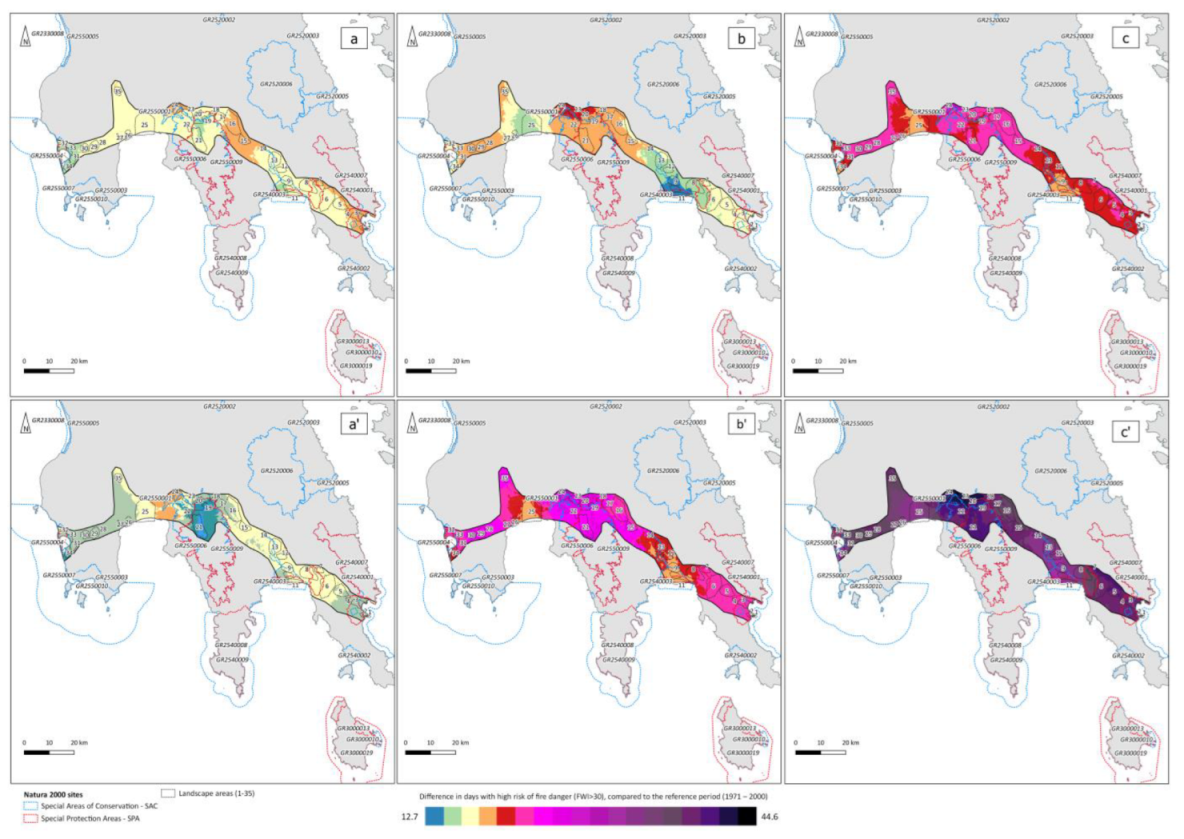
- In the favorable scenario (RCP2.6), the change will range from 9.37 to 17.93 days. The smallest change (9.37–10 days) is found in the central and southern part of the Taygetos area (landscape area 21) and secondarily in its wider area with a change of 12–14 days (landscape areas 18, 19, 20), as well as in area of Pylos (landscape area 34). The largest changes (16–17.2 days) are found in the wider area of Monemvasia (landscape areas 1, 2, 3, 4 (southeastern part), 5 (northern part), 6 (northern section) and 7 (most of the area). Intermediate values (12–16 days) prevail for the rest of the cross-sectional areas, as well as the selected landscape areas.
- In the intermediate scenario (RCP4.5), the range of change in cross-sectional area is from 16.43 to 26.75 days. That is, the most favorable conditions in this scenario are at the price of the most unfavorable conditions of the favorable scenario. If we consider the lowest observed range of 16.43–18 as a mere change, this is located in the areas of the two rivers, Pamissos and Evrotas (landscape areas 25 and 9, 10, 11, respectively). The maximum change values (24–26.75 days) are recorded in the central northern and southern parts of the transect and in landscape areas 20 (northern part), 21 (southern part), 23 and 24.
- In the worst-case scenario (RCP8.5), the change increases significantly across the region and the range of change is from 29.8 to 44.63 days. For this scenario, there is no reason to separate the areas and the landscape areas, since unfavorable fire risk conditions are recorded for the entire section.
3.7. Delineating and Prioritizing Vulnerable Areas
4. Discussion
4.1. Surveying with a Landscape Transect Method
4.2. The Transect Zone (Study Area)
4.3. Landscape Areas (Areal Units)
4.4. Landscape Viewpoints (LAP Assessment)
4.5. Landscape Typology
4.6. Projections Using Data and Models
4.7. Challanges and Limitations
- (a)
- Transect selection techniques rely on the configuration and extent of the transect zone; they must be clearly defined and substantiated through the research rationale. In this current study, the transect location was initially described within a major EU-funded research project (LIFE-IP AdaptInGR) with specific policy-relevant aims.
- (b)
- Identifying landscape areal units within the transect and accompanying viewpoints is prone to subjectivity that cannot be easily surpassed.
- (c)
- The transect is a sampling method not a concrete systematic organization of landscape units. In this, it differs from other initiatives, such as landscape character assessment, as being an exploratory method instead of systematic delineation framework.
- (d)
- Each delineation (landscape area and/or viewpoint) depends on the viewpoint and access point of the landscape. For this reason, these landscape areas are sample areas of the landscapes of the wider transect and of course often intersected by a central access road. As such, it is not easy to have absolute representativeness, especially in topographically heterogeneous areas.
- (e)
- The number of delineated landscape areas and viewpoints may seem arbitrary. In terms of areas and viewpoints, the “more the better” is a useful rule of thumb.
- (f)
- Assessing vulnerability depends both on data and the experience of the expert assessors involved in the research and analysis. Initial landscape typologies and mapping areas of outstanding interest stand as preliminary screening-level applications that may require further future verification.
4.8. Insights and Recommendations
- (a)
- Inventory and landscape mapping to integrate issues of landscape within climate change adaptation at the regional scale (i.e., within the entire region of the Peloponnese);
- (b)
- A focus on protecting landscape areas within the framework of formal protected areas that should include culturally important features of the landscape as well as the country’s protected-area system (i.e., both inside and outside the designated Natura 2000 sites);
- (c)
- Special efforts for forest and rangeland management to manage wildfire and affect the homogenizing effect of fire-prone scrubland spread due to mass agro-pastoral abandonment;
- (d)
- Special efforts for water and water-dependent biodiversity conservation, including restoration initiatives in rivers, particularly river deltas that include flood-prone zones;
- (e)
- Peri-urban and coastal sprawl problems and enforcement of all laws and protected area zoning;
- (f)
- Incorporating locally perceived landscape values and promoting landscape literacy in the local population.
5. Conclusions
Author Contributions
Funding
Institutional Review Board Statement
Informed Consent Statement
Data Availability Statement
Acknowledgments
Conflicts of Interest
Appendix A
| Page | Context | Applicable to Conservation | |
|---|---|---|---|
| 1 | 63 | Reference to landscapes of outstanding natural beauty. | Low |
| 2 | 63 | List of landscapes of outstanding natural beauty. | Moderate |
| 3 | 66 | List of protected traditional settlements. | Moderate |
| 4 | 67 | “Pollution” issues with a phrase referring to “wider landscape”, not specific to landscape itself. | Low |
| 5 | 67 | Lignite mining degrading landscape. | Moderate |
| 6 | 67 | Lignite mining degrading landscape. | Moderate |
| 7 | 165 | General reference to protected areas. | Low |
| 8 | 165 | General reference to wilderness landscape. | Low |
| 9 | 165 | General reference to agricultural landscape. | Low |
| 10 | 190 | General reference to farming of currant raisin landscape. | Low |
| 11 | 191 | General reference transhumance livestock grazing and landscape. | Low |
| 12 | 201 | Reference to the “General Land-Use Framework” law (ΦΕΚ 128/A/2008), which includes as one of its aims the protection of the landscape. | Moderate |
| 13 | 202 | Policy-relevant landscape conservation, especially with respect for peri-urban sprawl. | Moderate |
| 14 | 272 | General reference to landscape degradation caused by wildfires. | Low |
| 15 | 455 | General reference to indirect effects of climate change on the “natural landscape” including coastal erosion and habitat degradation. | Low |
| 16 | 506 | Reference to landscape rehabilitation of lignite mining. | High |
| 17 | 565 | Specific reference to the degradation caused by disease to forests and vegetation including invasive species. Monitoring and surveillance promoted as solutions. | High |
References
- Antrop, M.; Van Eetvelde, V. Territory and/or Scenery: Concepts and Prospects of Western Landscape Research. In Current Trends in Landscape Research; Mueller, L., Eulenstein, F., Eds.; Springer: Müncheberg/Brandenburg, Germany, 2019; pp. 3–39. [Google Scholar]
- Warnock, S.; Griffiths, G. Landscape characterization: The living landscapes approach in the UK. Landsc. Res. 2015, 40, 261–278. [Google Scholar] [CrossRef]
- Zube, E.H. Themes in landscape assessment theory. Landsc. J. 1984, 3, 104–110. [Google Scholar] [CrossRef]
- Smardon, R. Ecosystem services for scenic quality landscape management: A review. Land 2021, 10, 1123. [Google Scholar] [CrossRef]
- Angelstam, P.; Munoz-Rojas, J.; Pinto-Correia, T. Landscape concepts and approaches foster learning about ecosystem services. Landsc. Ecol. 2019, 34, 1445–1460. [Google Scholar] [CrossRef]
- Opdam, P.; Wascher, D. Climate change meets habitat fragmentation: Linking landscape and biogeographical scale levels in research and conservation. Biol. Conserv. 2004, 117, 285–297. [Google Scholar] [CrossRef]
- Zhang, S. Knowledge Mapping Analysis of the Study of Ecosystem Services and Landscape Architecture. Ph.D. Dissertation, American Society of Civil Engineers, Reston, VA, USA, 2022. [Google Scholar]
- Sheppard, S.R. Making climate change visible: A critical role for landscape professionals. Landsc. Urban Plan. 2015, 142, 95–105. [Google Scholar] [CrossRef]
- Lin, Y.P.; Chen, C.J.; Lien, W.Y.; Chang, W.H.; Petway, J.R.; Chiang, L.C. Landscape conservation planning to sustain ecosystem services under climate change. Sustainability 2019, 11, 1393. [Google Scholar] [CrossRef]
- Land Use Consultants. An Assessment of the Impacts of Climate Change on Scottish Landscapes and Their Contribution to Quality of Life: Phase 1—Final Report; Scottish Natural Heritage Commissioned Report No. 488; Scottish Natural Heritage: Inverness, UK, 2011. [Google Scholar]
- Raymond, C.M.; Brown, G. Assessing spatial associations between perceptions of landscape value and climate change risk for use in climate change planning. Clim. Change 2011, 104, 653–678. [Google Scholar] [CrossRef]
- Bizikova, L.; Crawford, E.; Nijnik, M.; Swart, R. Climate change adaptation planning in agriculture: Processes, experiences and lessons learned from early adapters. Mitig. Adapt. Strat. Glob. Change 2014, 19, 411–430. [Google Scholar] [CrossRef]
- Köpsel, V.; Walsh, C.; Leyshon, C. Landscape narratives in practice: Implications for climate change adaptation. Geogr. J. 2017, 183, 175–186. [Google Scholar] [CrossRef]
- Froese, R.; Schilling, J. The Nexus of Climate Change, Land Use, and Conflicts. Curr. Clim. Change Rep. 2019, 5, 24–35. [Google Scholar] [CrossRef]
- Solecka, I. The use of landscape value assessment in spatial planning and sustainable land management—A review. Landsc. Res. 2019, 44, 966–981. [Google Scholar] [CrossRef]
- Kokkoris, I.P.; Mallinis, G.; Bekri, E.; Vlami, V.; Zogaris, S.; Chrysafis, I.; Mitsopoulos, I.; Dimopoulos, P. National Set of MAES Indicators in Greece: Ecosystem Services and Management Implications. Forests 2020, 11, 595. [Google Scholar] [CrossRef]
- Vlami, V.; Zogaris, S.; Djuma, H.; Kokkoris, I.P.; Kehayias, G.; Dimopoulos, P. A field method for landscape conservation surveying: The landscape assessment protocol (LAP). Sustainability 2019, 11, 2019. [Google Scholar] [CrossRef]
- Zhou, T.; Ren, W.; Peng, S.; Liang, L.L.; Ren, S.; Wu, J. A riverscape transect approach to studying and restoring river systems: A case study from southern China. Ecol. Eng. 2014, 65, 147–158. [Google Scholar] [CrossRef]
- Zhang, Z.; Tu, Y.J.; Li, X. Quantifying the spatiotemporal patterns of urbanization along urban-rural gradient with a roadscape transect approach: A case study in Shanghai, China. Sustainability 2016, 8, 862. [Google Scholar] [CrossRef]
- Kizos, T.; Verburg, P.; Bürgi, M.; Gounaridis, D.; Plieninger, T.; Bieling, C.; Balatsos, T. From concepts to practice: Combining different approaches to understand drivers of landscape change. Ecol. Soc. 2018, 23, 25. [Google Scholar] [CrossRef]
- Allen, T.F.H.; Hoekstra, T.W. Toward a Definition of Sustainability. In Sustainable Ecological Systems: Implementing an Ecological Approach to Land Management; Rocky Mountain Forest and Range Experiment Station: Fort Collins, CO, USA, 1994; pp. 98–107. [Google Scholar]
- Thompson, I.D.; Flannigan, M.D.; Wotton, B.M.; Suffling, R. The effects of climate change on landscape diversity: An example in Ontario forests. Environ. Monit. Assess. 1998, 49, 213–233. [Google Scholar] [CrossRef]
- Kail, J.; Januschke, K.; Hering, D. Freshwater-related species richness in Natura 2000 sites strongly depends on the surrounding land use besides local habitat conditions. J. Environ. Manag. 2023, 340, 118025. [Google Scholar] [CrossRef]
- Maltby, E. The Wetlands Paradigm Shift in Response to Changing Societal Priorities: A Reflective Review. Land 2022, 11, 1526. [Google Scholar] [CrossRef]
- Melnick, R.Z.; Kerr, N.P.; Malinay, V.; Burry-Trice, O. Climate Change and Cultural Landscapes: A Guide to Research, Planning, and Stewardship. Cultural Landscape Guidance Documents; Cultural Landscape Research Group, Department of Landscape Architecture, University of Oregon: Eugene, OR, USA, 2017; p. 59. [Google Scholar]
- Galan, J.; Galiana, F.; Kotze, D.J.; Lynch, K.; Torreggiani, D.; Pedroli, B. Landscape adaptation to climate change: Local networks, social learning and co-creation processes for adaptive planning. Glob. Environ. Change 2023, 78, 102627. [Google Scholar]
- Glick, P.; Stein, B.A.; Edelson, N.A. Scanning the Conservation Horizon: A Guide to Climate Change Vulnerability Assessment; National Wildlife Federation: Washington, DC, USA, 2011; p. 168. [Google Scholar]
- Yousefpour, R.; Jacobsen, J.B.; Thorsen, B.J.; Meilby, H.; Hanewinkel, M.; Oehler, K.A. Review of decision-making approaches to handle uncertainty and risk in adaptive forest management under climate change. Ann. For. Sci. 2011, 69, 1–15. [Google Scholar]
- Biesbroek, G.R.; Swart, R.J.; Carter, T.R.; Cowan, C.; Henrichs, T.; Mela, H.; Morecroft, M.D.; Rey, D. Europe adapts to climate change: Comparing national adaptation strategies. Glob. Environ. Change 2010, 20, 440–450. [Google Scholar]
- Bürgi, M.; Celio, E.; Diogo, V.; Hersperger, A.M.; Kizos, T.; Lieskovsky, J.; Pazur, R.; Plieninger, T.; Prishchepov, A.V.; Verburg, P.H. Advancing the study of driving forces of landscape change. J. Land Use Sci. 2022, 17, 540–555. [Google Scholar]
- Cook, I.; Johnston, R.; Selby, K. Climate change and cultural heritage: A landscape vulnerability framework. J. Isl. Coast. Archaeol. 2021, 16, 553–571. [Google Scholar]
- Council of Europe. Council of Europe Landscape Convention Website. 2000. Available online: https://www.coe.int/en/web/conventions/full-list?module=treaty-detail&treatynum=176 (accessed on 2 April 2023).
- Stanturf, J.A. Future landscapes: Opportunities and challenges. New For. 2015, 46, 615–644. [Google Scholar]
- Marson, A. Landscape in Spatial Planning: Some Evidence on Methodological Issues and Political Challenges. Land 2023, 12, 827. [Google Scholar]
- Tsilimigkas, G.; Kizos, T. Space, pressures and the management of the Greek landscape. Geogr. Ann. Ser. B Hum. Geogr. 2014, 96, 159–175. [Google Scholar]
- Kyvelou, S.S.; Gourgiotis, A. Landscape as connecting link of nature and culture: Spatial planning policy implications in Greece. Urban Sci. 2019, 3, 81. [Google Scholar]
- Pavlis, E.; Terkenli, T. Landscape values and the question of cultural sustainability: Exploring an uncomfortable relationship in the case of Greece. Nor. Geogr. Tidsskr. 2017, 71, 168–188. [Google Scholar]
- Terkenli, T.S. Landscape and justice: The case of Greeks, space and law. Landsc. Res. 2022, 47, 797–810. [Google Scholar]
- Vlami, V.; Kokkoris, I.P.; Zogaris, S.; Cartalis, C.; Kehayias, G.; Dimopoulos, P. Cultural landscapes and attributes of “culturalness” in protected areas: An exploratory assessment in Greece. Sci. Total Environ. 2017, 595, 229–243. [Google Scholar] [PubMed]
- Vlami, V.; Kokkoris, I.P.; Zogaris, S.; Kehayias, G.; Dimopoulos, P. Cultural ecosystem services in the Natura 2000 network: Introducing proxy indicators and conflict risk in Greece. Land 2020, 10, 4. [Google Scholar]
- Pediaditi, K.; Moquay, P. Landscape injustices in polarised communities: Unearthing perceptions at Sitia UNESCO Geopark, Greece. Landsc. Res. 2022, 47, 767–782. [Google Scholar]
- Lazoglou, M.; Serraos, K. Climate change adaptation through spatial planning: The case study of the region of Western Macedonia. In IOP Conference Series: Earth and Environmental Science; IOP Publishing: Bristol, UK, 2021; Volume 899, p. 012021. [Google Scholar]
- Trovato, M.G.; Ali, D. Planning tools for the protection of the natural and cultural heritage in the Eastern Mediterranean area. In Current Trends in Landscape Research; Mueller, L., Eulenstein, F., Eds.; Leibniz Centre for Agricultural Landscape Research (ZALF): Müncheberg/Brandenburg, Germany, 2019; pp. 467–486. [Google Scholar]
- Imeson, A.C.; Lavee, H. Soil erosion and climate change: The transect approach and the influence of scale. Geomorphology 1998, 23, 219–227. [Google Scholar]
- Braae, E.; Diedrich, L.; Lee, G. The travelling transect: Capturing island dynamics, relationships and atmospheres in the water landscapes of the Canaries. In Proceedings of the Nordic Design Research Conference, Malmö, Sweden, 9–12 June 2013; pp. 191–200. Available online: www.nordes.org (accessed on 13 January 2021).
- Han, S. The use of transects for resilient design: Core theories and contemporary projects. Landsc. Ecol. 2021, 36, 1567–1582. [Google Scholar]
- Medley, K.E.; McDonnell, M.J.; Pickett, S.T. Forest-landscape structure along an urban-to-rural gradient. Prof. Geogr. 1995, 47, 159–168. [Google Scholar]
- Diedrich, L.; Lee, G.; Braae, E. The Transect as a Method for Mapping and Narrating Water Landscapes: Humboldt’s Open Works and Transareal Travelling; NANO New American Notes Online: New York, NY, USA, 2014. [Google Scholar]
- Duany, A.; Talen, E. Transect Planning. J. Am. Plann. Assoc. 2002, 68, 245–266. [Google Scholar] [CrossRef]
- Francis, C.; Morse, S.; Breland, T.A.; Lieblein, G. Transect walks across farms and landscapes. NACTA J. 2012, 56, 92–94. [Google Scholar]
- Parker, C.; Owens, P.E. A line through a City: Using transects to uncover patterns, experiences and histories of everyday landscapes. In Routledge Handbook of Urban Landscape Research, 1st ed.; Routledge: Oxfordshire, UK, 2022; ISBN 9781003109563. [Google Scholar]
- Steiner, F.R.; Thompson, G.F.; Carbonell, A. Nature and Cities: The Ecological Imperative in Urban Design and Planning; Lincoln Institute of Land Policy: Cambridge, MA, USA, 2016. [Google Scholar]
- Guan, B.; Gao, J.; Chen, W.; Gong, X.; Ge, G. The Effects of Climate Change on Landscape Connectivity and Genetic Clusters in a Small Subtropical and Warm-Temperate Tree. Front. Plant Sci. 2021, 12, 671336. [Google Scholar]
- Koch, G.W.; Vitousek, P.M.; Steffen, W.L.; Walker, B.H. Terrestrial transects for global change research. Vegetatio 1995, 121, 53–65. [Google Scholar]
- NTUA (National Technical University of Athens). Filotis Database for Greek Nature. 2010. Available online: https://filotis.itia.ntua.gr/ (accessed on 8 October 2021).
- Gavriilidou, E.; Tzamou, C.; Pougakioti, V. Database Documenting M and E Methodologies and Indicators Pertinent to Adaptation Actions Covering All Vulnerable Sector: Landscape/Land-Uses; LIFE-IP AdaptInGR–Boosting the Implementation of Adaptation Policy Across Greece LIFE17 IPC/GR/000006” Deliverable “Sub-Action A2.D2; ELLET (Elliniki Etairia—Society for the Environment and Cultural Heritage): Athens, Greece, 2020; Technical Report; pp. 1–166. [Google Scholar]
- Caloiero, T.; Callegari, G.; Cantasano, N.; Coletta, V.; Pellicone, G.; Veltri, A. Bioclimatic analysis in a region of southern Italy (Calabria). Plant Biosyst. 2015, 150, 1282–1295. [Google Scholar]
- Vessella, F.; Schirone, B. Forest Conservation and Restoration Using the Emberger Index: Cork Oak as Study Case. Forests 2022, 13, 252. [Google Scholar]
- ELLET (Elliniki Etairia—Society for the Environment and Cultural Heritage). Development of Pilot Assessments and Adaptation Guidelines for Landscapes and Land-Uses. Case Study: Landscape and Land Uses, The Transect method from Pylos to Monemvasia; LIFE-IP AdaptInGR–Boosting the Implementation of Adaptation Policy Across Greece LIFE17 IPC/GR/000006” Deliverable “Sub-Action C4.D1: Draft Report; ELLET: Athens, Greece, 2021. [Google Scholar]
- Region of Peloponnese and Athens Academy. RAAP of the Peloponnese. Final Report; 2020; 843p. Available online: https://www.ppel.gov.gr/wp-content/uploads/2020/10/%CE%A0%CE%B5%CE%A3%CE%A0%CE%9A%CE%91-%CE%A0%CE%B5%CE%BB%CE%BF%CF%80%CE%BF%CE%BD%CE%BD%CE%B7%CC%81%CF%83%CE%BF%CF%85_v1.pdf (accessed on 19 April 2023).
- Derdous, O.; Tachi, S.E.; Bouguerra, H. Spatial distribution and evaluation of aridity indices in Northern Algeria. Arid. Land Res. Manag. 2021, 35, 1–14. [Google Scholar] [CrossRef]
- Bartlett, D.; Gomez-Martin, E.; Milliken, S.; Parmer, D. Introducing landscape character assessment and the ecosystem service approach to India: A case study. Landsc. Urban Plan. 2017, 167, 257–266. [Google Scholar]
- Stefani, E.; Tsilimigas, G. The landscape in spatial planning: Critical approach of the degraded Greek insular landscapes in regional spatial planning. Aechoros 2023, 36, 32–42, (In Greek with English Abstract). [Google Scholar]
- Tsilimigkas, G.; Gourgiotis, A.; Derdemezi, E.T. Spatial planning incompetence to discourage urban sprawl on Greek Islands. Evidence from Paros, Greece. J. Coast. Conserv. 2022, 26, 11. [Google Scholar]
- Beriatos, E. Greek landscape: Problems, policies, perspectives. In Reclaiming the Greek Landscape; Papayannis, T., Howard, P., Eds.; Med-INA: Athina, Greece, 2012; pp. 123–132. [Google Scholar]
- Vlantou, A. The Landscape as Environmental Good: Incompatibility between the Right to Protection and the Reality. Available online: http://www.nomosphysis.org.gr (accessed on 10 May 2023). (In Greek).
- Tsilimigkas, G.; Kizos, T.; Gourgiotis, A. Unregulated Urban Sprawl and Spatial Distribution of Fire Events: Evidence from Greece. Environ. Hazards 2018, 17, 436–455. [Google Scholar] [CrossRef]
- Mentzafou, A.; Dimitriou, E. Hydrological Modeling for Flood Adaptation under Climate Change: The Case of the Ancient Messene Archaeological Site in Greece. Hydrology 2022, 9, 19. [Google Scholar]
- Terkenli, T.S.; Gkoltsiou, A.; Kavroudakis, D. The Interplay of Objectivity and Subjectivity in Landscape Character Assessment: Qualitative and Quantitative Approaches and Challenges. Land 2021, 10, 53. [Google Scholar]
- Tveit, M.; Ode, A.; Fry, G. Key concepts in a framework for analyzing visual landscape character. Landsc. Res. 2006, 31, 229–255. [Google Scholar] [CrossRef]
- Gobster, P.H.; Ribe, R.G.; Palmer, J.F. Themes and trends in visual assessment research: Introduction to the Landscape and Urban Planning special collection on the visual assessment of landscapes. Landsc. Urban Plan. 2019, 191, 103635. [Google Scholar] [CrossRef]
- Wu, Z.; Wang, Y.; Gan, W.; Zou, Y.; Dong, W.; Zhou, S.; Wang, M.A. Survey of the Landscape Visibility Analysis Tools and Technical Improvements. Int. J. Environ. Res. Public Health 2023, 20, 1788. [Google Scholar] [CrossRef]
- Medeiros, A.; Fernandes, C.; Gonçalves, J.F.; Farinha-Marques, P. Research trends on integrative landscape assessment using indicators–A systematic review. Ecol. Indic. 2021, 129, 107815. [Google Scholar] [CrossRef]
- Manning, J.; Macleod, C.; Lucieer, V. Seascape Visual Characterization: Combining Viewing Geometry and Physical Features to Quantify the Perception of Seascape. Sustainability 2023, 15, 8009. [Google Scholar] [CrossRef]
- Groves, C. Drafting a Conservation Blueprint: A Practitioner’s Guide to Planning for Biodiversity; Island Press: Covelo, CA, USA, 2003. [Google Scholar]
- Carlier, J.; Moran, J. Landscape typology and ecological connectivity assessment to inform Greenway design. Sci. Total Environ. 2019, 651, 3241–3252. [Google Scholar] [CrossRef]
- Zogaris, S.; Economou, A.N.; Dimopoulos, P. Ecoregions in the southern Balkans: Should their boundaries be revised? Environ. Manag. 2009, 43, 682–697. [Google Scholar] [CrossRef]
- Vogiatzakis, I.N.; Griffiths, G.H.; Melis, M.T.; Marini, A.; Careddu, M.B. Landscape typology in the Mediterranean context: A tool for habitat restoration. J. Mediterr. Ecol. 2006, 7, 23. [Google Scholar]
- Charalampopoulos, I.; Droulia, F. Frost Conditions Due to Climate Change in South-Eastern Europe via a High-Spatiotemporal-Resolution Dataset. Atmosphere 2022, 13, 1407. [Google Scholar] [CrossRef]
- Charalampopoulos, I.; Droulia, F.; Tsiros, I.X. Projecting Bioclimatic Change over the South-Eastern European Agricultural and Natural Areas via Ultrahigh-Resolution Analysis of the de Martonne Index. Atmosphere 2023, 14, 858. [Google Scholar] [CrossRef]
- Rovithakis, A.; Grillakis, M.G.; Seiradakis, K.D.; Giannakopoulos, C.; Karali, A.; Field, R.; Lazaridis, M.; Voulgarakis, A. Future climate change impact on wildfire danger over the Mediterranean: The case of Greece. Environ. Res. Lett. 2022, 17, 045022. [Google Scholar] [CrossRef]
- Farsø, M.; Henriksson, A. Defined by deviations: The Traveling Transect as a bodily research approach to appropriate and disseminate places. Spool 2016, 3, 5–22. [Google Scholar]
- Prokopová, M.; Salvati, L.; Egidi, G.; Cudlín, O.; Včeláková, R.; Plch, R.; Cudlín, P. Envisioning present and future land-use change under varying ecological regimes and their influence on landscape stability. Sustainability 2019, 11, 4654. [Google Scholar] [CrossRef]
- Anandhi, A. CISTA-A: Conceptual model using indicators selected by systems thinking for adaptation strategies in a changing climate: Case study in agro-ecosystems. Ecol. Model. 2017, 345, 41–55. [Google Scholar] [CrossRef]
- Escobedo, F.J.; Bottin, M.; Clerici, N.; Camargo, S.G.; Feged-Rivadeneira, A. Evaluating the role of spatial landscape literacy in public participation processes and opinions on environmental issues and ecosystem services. Environ. Manag. 2022, 69, 244–257. [Google Scholar] [CrossRef] [PubMed]
- Opdam, P. Implementing human health as a landscape service in collaborative landscape approaches. Landsc. Urban Plan. 2020, 199, 103819. [Google Scholar] [CrossRef]
- Kefalas, G.; Kalogirou, S.; Poirazidis, K.; Lorilla, R.S. Landscape transition in Mediterranean islands: The case of Ionian islands, Greece 1985–2015. Landsc. Urban Plan. 2019, 191, 103641. [Google Scholar] [CrossRef]
- Skoulikidis, N.T.; Vardakas, L.; Karaouzas, I.; Economou, A.N.; Dimitriou, E.; Zogaris, S. Assessing water stress in Mediterranean lotic systems: Insights from an artificially intermittent river in Greece. Aquat. Sci. 2011, 73, 581–597. [Google Scholar] [CrossRef]
- Kokkoris, I.P.; Bekri, Ε.S.; Skuras, D.; Vlami, V.; Zogaris, S.; Maroulis, G.; Dimopoulos, D.; Dimopoulos, P. Integrating MAES implementation into protected area management under climate change: A fine-scale application in Greece. Sci. Total Environ. 2019, 695, 133530. [Google Scholar] [CrossRef]
- Grove, A.T.; Rackham, O. The Nature of Mediterranean Europe: An Ecological History; Yale University Press: London, UK, 2003; Volume 93, pp. 494–498. [Google Scholar]
- Rackham, O. Observations on the historical ecology of Laconia. In Continuity and Change in a Greek Rural Landscape “The Laconia Survey” Methodology and Interpretation; Cavanagh, W., Ed.; The Council, British School of Athens: Athens, Greece, 2002; Volume 1, pp. 73–119. [Google Scholar]
- Balzan, M.V.; Pinheiro, A.M.; Mascarenhas, A.; Morán-Ordóñez, A.; Ruiz-Frau, A.; Carvalho-Santos, C.; Vogiatzakis, I.; Arends, J.; Santana-Garcon, J.; Roces-Díaz, J.V.; et al. Improving ecosystem assessments in Mediterranean social-ecological systems: A DPSIR analysis. Ecosyst. People 2019, 15, 136–155. [Google Scholar] [CrossRef]
- Lazoglou, M. Strengthening the Resilience of Coastal Cities against Climate Change through Spatial Planning: Evidence from Greece. Curr. Urban Stud. 2022, 10, 639–654. [Google Scholar] [CrossRef]
- Tzanopoulos, J.; Kallimanis, A.S.; Bella, I.; Labrianidis, L.; Sgardelis, S.; Pantis, J.D. Agricultural decline and sustainable development on mountain areas in Greece: Sustainability assessment of future scenarios. Land Use Policy 2011, 28, 585–593. [Google Scholar] [CrossRef]
- Brotons, L.; Aquilué, N.; De Cáceres, M.; Fortin, M.J.; Fall, A. How fire history, fire suppression practices and climate change affect wildfire regimes in Mediterranean landscapes. PLoS ONE 2013, 8, e62392. [Google Scholar] [CrossRef]
- Fuldauer, L.; Thacker, S.; Haggis, R.; Nerini, F.F.; Nicholls, R.; Hall, J. Targeting adaptation to safeguard sustainable development against climate-change impacts. Nat. Commun. 2021, 13, 3579. [Google Scholar] [CrossRef]
- Rault, P.A.K.; Koundouri, P.; Akinsete, E.; Ludwig, R.; Huber-Garcia, V.; Tsani, S.; Acuna, V.; Kalogianni, E.; Luttik, J.; Kok, K.; et al. Down scaling of climate change scenarii to river basin level: A transdisciplinary methodology applied to Evrotas river basin, Greece. Sci. Total Environ. 2019, 660, 1623–1632. [Google Scholar] [CrossRef]
- Maneas, G.; Makopoulou, E.; Bousbouras, D.; Berg, H.; Manzoni, S. Anthropogenic changes in a Mediterranean Coastal Wetland during the last century-The case of Gialova Lagoon, Messinia, Greece. Water 2019, 11, 350. [Google Scholar] [CrossRef]
- Fraga, H.; Moriondo, M.; Leolini, L.; Santos, J.A. Mediterranean Olive Orchards under Climate Change: A Review of Future Impacts and Adaptation Strategies. Agronomy 2020, 11, 56. [Google Scholar] [CrossRef]
- Smeti, E.; Kalogianni, E.; Karaouzas, I.; Laschou, S.; Tornes, E.; De Castro-Catala, N.; Anastasopoulou, E.; Koutsodimou, M.; Andriopoulou, A.; Vardakas, L.; et al. Effects of olive mill wastewater discharge on benthic biota in Mediterranean streams. Environ. Pollut. 2019, 254, 113057. [Google Scholar] [CrossRef] [PubMed]
- Hermoso, V.; Morán-Ordóñez, A.; Brotons, L. The role of Natura 2000 at maintaining dynamic landscapes in Europe over the last two decades: Implications for conservation. In Current Trends in Landscape Research; Mueller, L., Eulenstein, F., Eds.; Lothar Mueller Guest Scientist Leibniz Centre for Agricultural Landscape Research (ZALF): Müncheberg/Brandenburg, Germany, 2019; pp. 665–680. [Google Scholar]
- Ayati, K.; Hupało, K.; Dhaouadi, S.; Rewicz, T.; Grabowski, M.; Piscart, C. Conservation of freshwater biodiversity in Tunisia in a climate change context: Combining amphipod distribution data and molecular analyses to improve priorities. Biodivers. Conserv. 2023, 32, 2539–2559. [Google Scholar] [CrossRef]
- Manzoni, S.; Maneas, G.; Scaini, A.; Psiloglou, B.E.; Destouni, G.; Lyon, S.W. Understanding coastal wetland conditions and futures by closing their hydrologic balance: The case of the Gialova lagoon, Greece. Hydrol. Earth Syst. Sci. 2020, 24, 3557–3571. [Google Scholar] [CrossRef]
- Krawczyk, E.; Hedman, H.; Pafilis, P.; Bergen, K.; Foufopoulos, J. Effects of touristic development on Mediterranean island wildlife. Landsc. Ecol. 2019, 34, 2719–2734. [Google Scholar] [CrossRef]
- Von Holle, B.; Yelenik, S.; Gornish, E.S. Restoration at the landscape scale as a means of mitigation and adaptation to climate change. Curr. Landsc. Ecol. Rep. 2020, 5, 85–97. [Google Scholar] [CrossRef]
- Zogaris, S.; Skoulikidis, N.; Dimitriou, E. River and wetland restoration in Greece: Lessons from biodiversity conservation initiatives. In The Rivers of Greece: Evolution, Current Status and Perspectives; Springer: Berlin/Heidelberg, Germany, 2018; pp. 403–431. [Google Scholar]
- Alizadeh, B.; Hitchmough, J. A review of urban landscape adaptation to the challenge of climate change. Int. J. Clim. Change Strat. Manag. 2019, 11, 178–194. [Google Scholar] [CrossRef]
- Albrich, K.; Rammer, W.; Seidl, R. Climate change causes critical transitions and irreversible alterations of mountain forests. Glob. Change Biol. 2020, 26, 4013–4027. [Google Scholar] [CrossRef] [PubMed]
- Puerta-Piñero, C.; Espelta, J.M.; Sánchez-Humanes, B.; Rodrigo, A.; Coll, L.; Brotons, L. History matters: Previous land use changes determine post-fire vegetation recovery in forested Mediterranean landscapes. For. Ecol. Manag. 2012, 279, 121–127. [Google Scholar] [CrossRef]
- Fernandes, P.M. Fire-smart management of forest landscapes in the Mediterranean basin under global change. Landsc. Urban Plan. 2013, 110, 175–1822. [Google Scholar] [CrossRef]
- Michalopoulos, G.; Kasapi, K.A.; Koubouris, G.; Psarras, G.; Arampatzis, G.; Hatzigiannakis, E.; Kavvadias, V.; Xiloyannis, C.; Montanaro, G.; Malliaraki, S.; et al. Adaptation of Mediterranean Olive Groves to Climate Change through Sustainable Cultivation Practices. Climate 2020, 8, 54. [Google Scholar] [CrossRef]
- Charalampopoulos, I. Agrometeorological Conditions and Agroclimatic Trends for the Maize and Wheat Crops in the Balkan Region. Atmosphere 2021, 12, 671. [Google Scholar] [CrossRef]
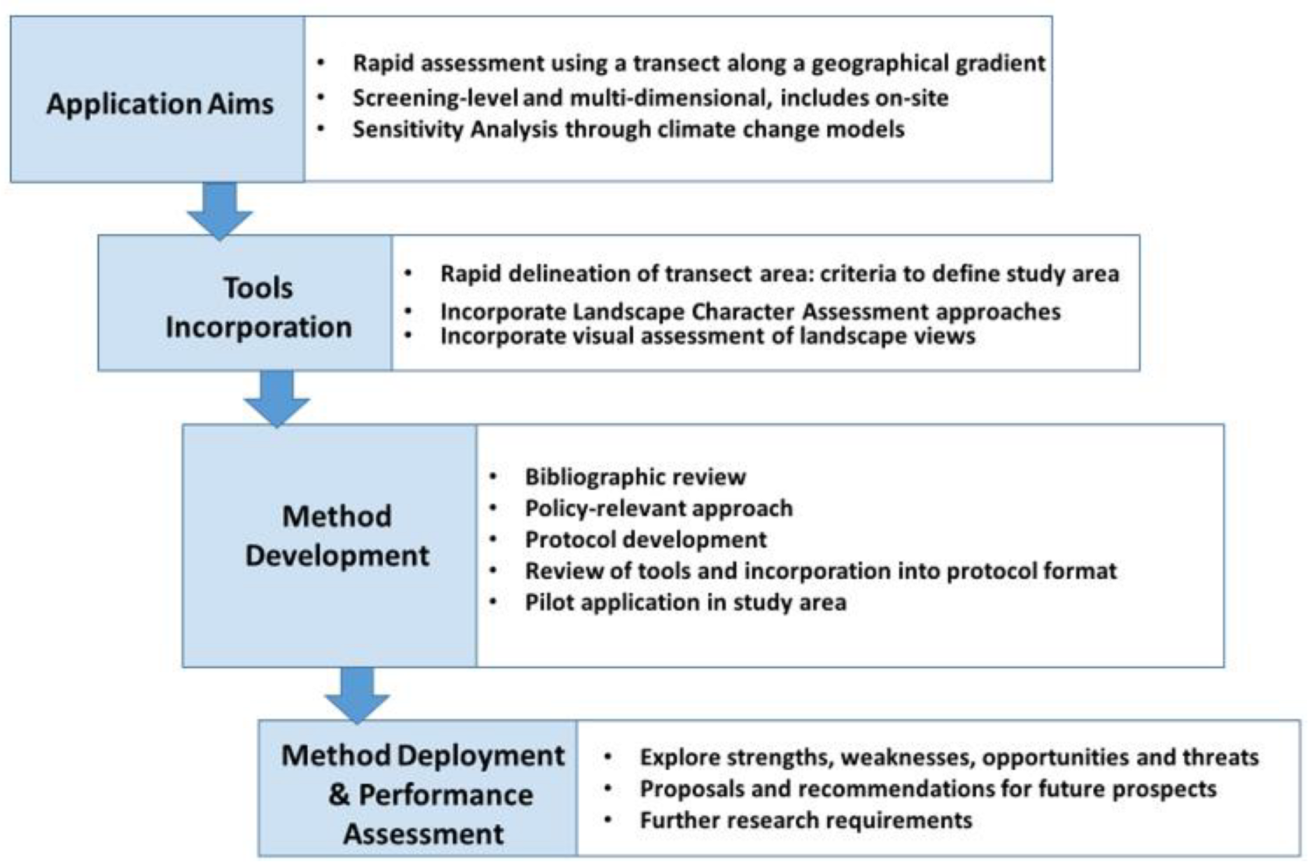

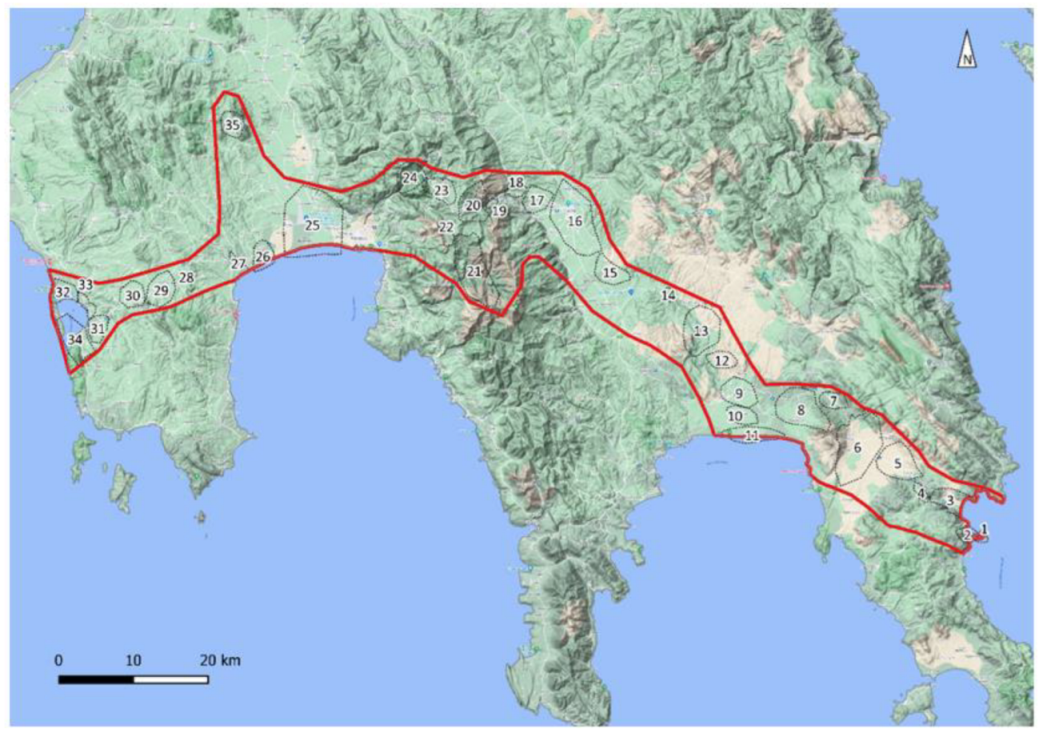





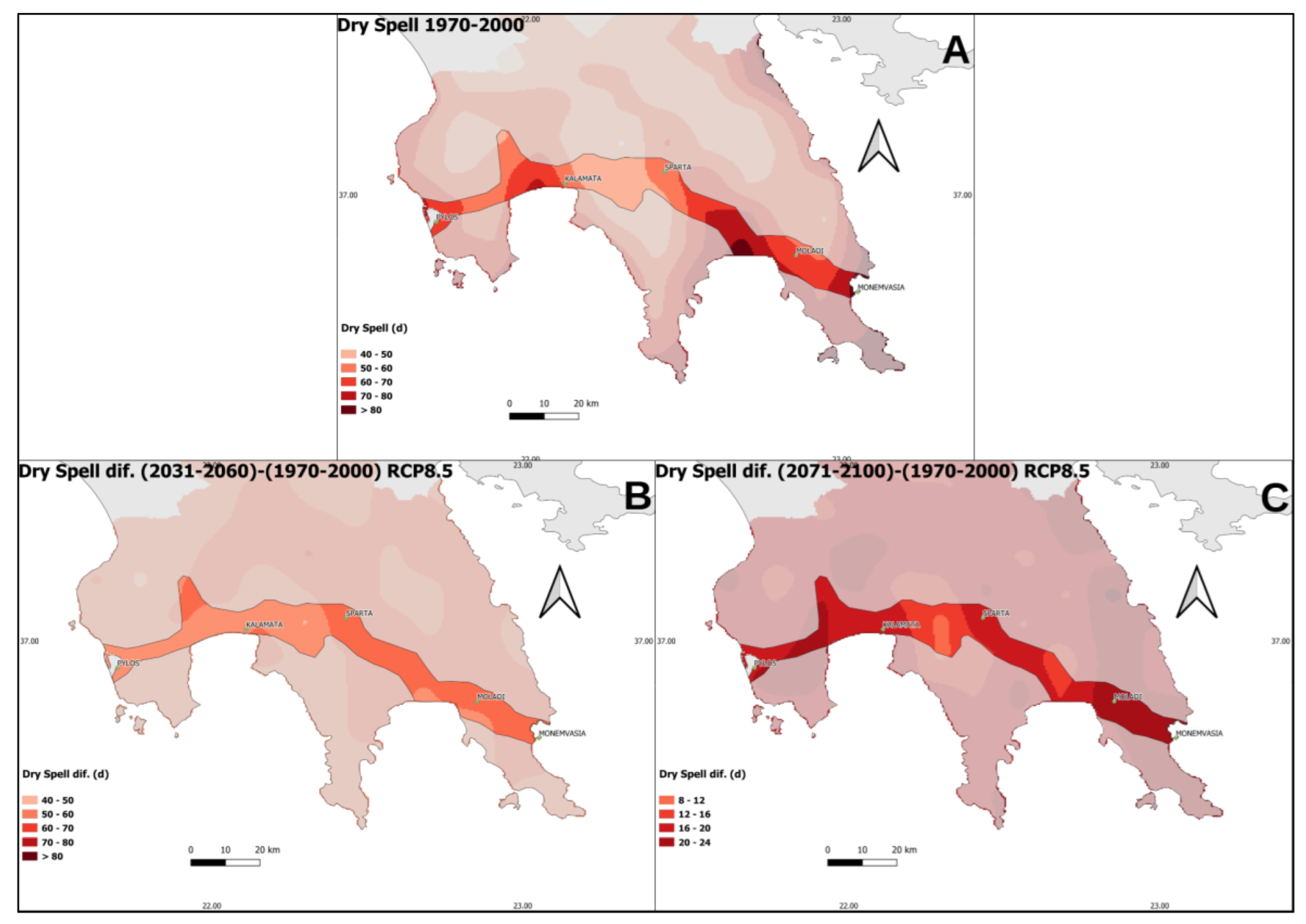

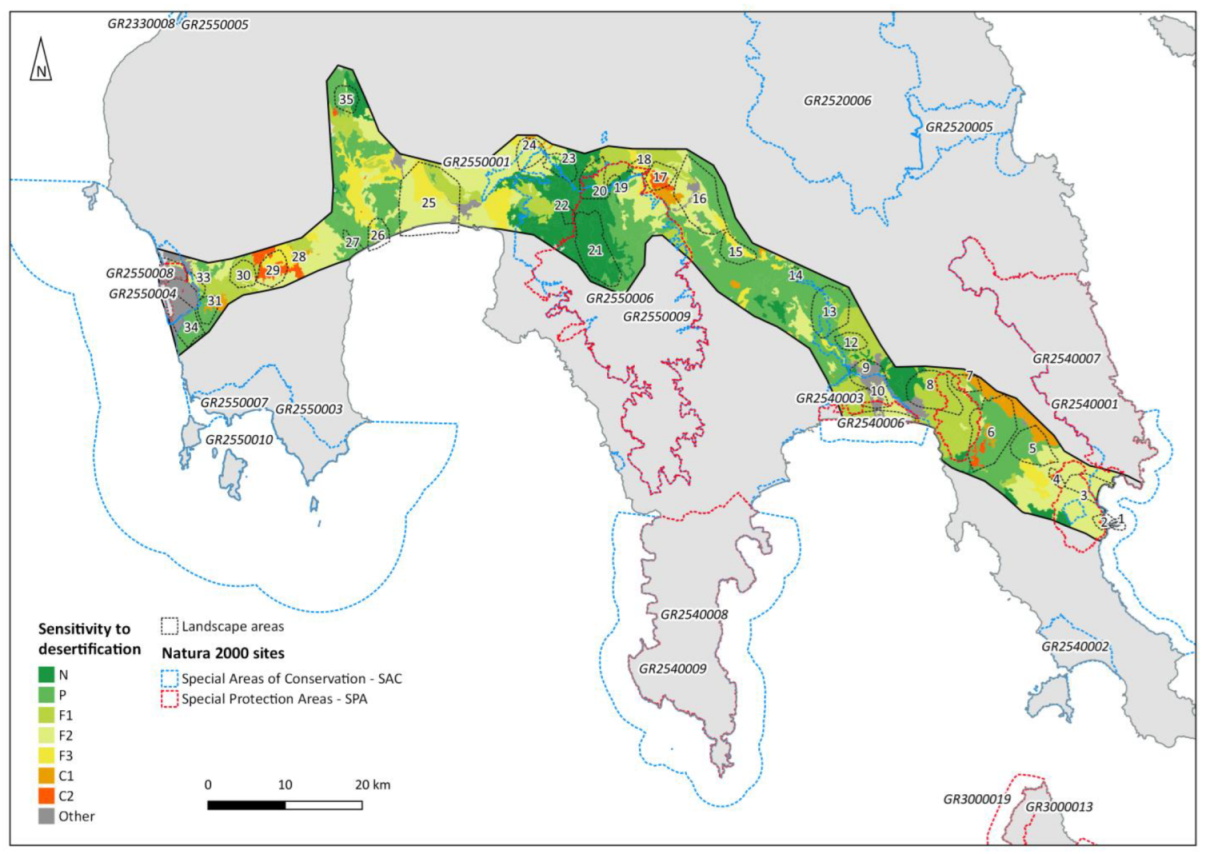
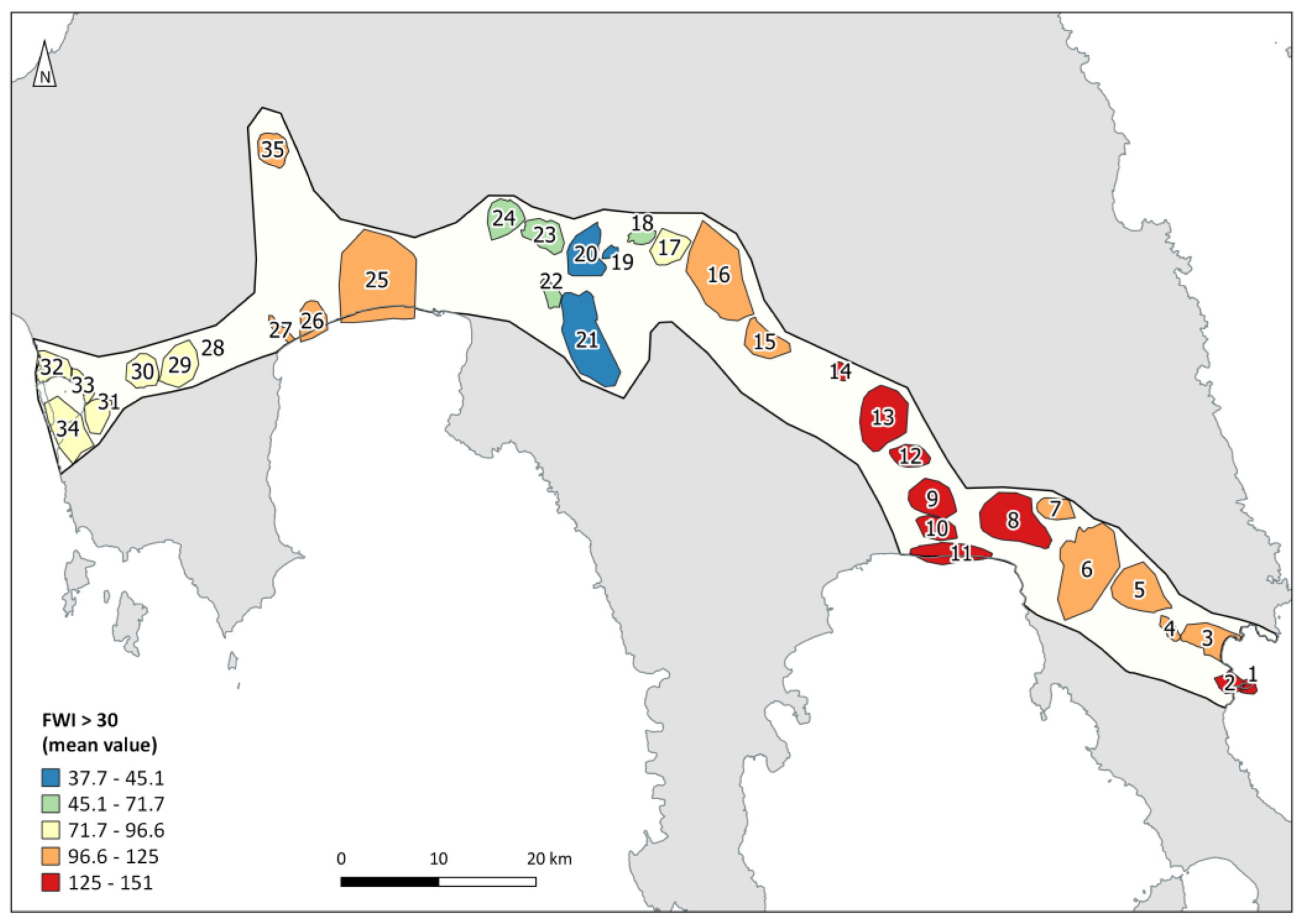

| Q Values | Types of Bioclimates/Phytoclimates |
|---|---|
| Q > 170 | Hyper-humid (or per-humid) |
| 120 ≤ Q ≤ 170 | Humid |
| 65 ≤ Q < 120 | Sub-humid |
| 30 ≤ Q < 65 | Semi-arid |
| 10 ≤ Q < 30 | Arid |
| Q < 10 | Hyper-arid (or per-arid) |
Disclaimer/Publisher’s Note: The statements, opinions and data contained in all publications are solely those of the individual author(s) and contributor(s) and not of MDPI and/or the editor(s). MDPI and/or the editor(s) disclaim responsibility for any injury to people or property resulting from any ideas, methods, instructions or products referred to in the content. |
© 2023 by the authors. Licensee MDPI, Basel, Switzerland. This article is an open access article distributed under the terms and conditions of the Creative Commons Attribution (CC BY) license (https://creativecommons.org/licenses/by/4.0/).
Share and Cite
Vlami, V.; Kokkoris, I.P.; Charalampopoulos, I.; Doxiadis, T.; Giannakopoulos, C.; Lazoglou, M. A Transect Method for Promoting Landscape Conservation in the Climate Change Context: A Case-Study in Greece. Sustainability 2023, 15, 13266. https://doi.org/10.3390/su151713266
Vlami V, Kokkoris IP, Charalampopoulos I, Doxiadis T, Giannakopoulos C, Lazoglou M. A Transect Method for Promoting Landscape Conservation in the Climate Change Context: A Case-Study in Greece. Sustainability. 2023; 15(17):13266. https://doi.org/10.3390/su151713266
Chicago/Turabian StyleVlami, Vassiliki, Ioannis P. Kokkoris, Ioannis Charalampopoulos, Thomas Doxiadis, Christos Giannakopoulos, and Miltiades Lazoglou. 2023. "A Transect Method for Promoting Landscape Conservation in the Climate Change Context: A Case-Study in Greece" Sustainability 15, no. 17: 13266. https://doi.org/10.3390/su151713266
APA StyleVlami, V., Kokkoris, I. P., Charalampopoulos, I., Doxiadis, T., Giannakopoulos, C., & Lazoglou, M. (2023). A Transect Method for Promoting Landscape Conservation in the Climate Change Context: A Case-Study in Greece. Sustainability, 15(17), 13266. https://doi.org/10.3390/su151713266







